Measuring Single-Molecule Conductance at An Ultra-Low Molecular Concentration in Vacuum
Abstract
1. Introduction
2. Materials and Methods
3. Results
4. Conclusions
Author Contributions
Funding
Conflicts of Interest
References
- Gonzalez, M.T.; Wu, S.; Huber, R.; van der Molen, S.J.; Schönenberger, C.; Calame, M. Electrical conductance of molecular junctions by a robust statistical analysis. Nano Lett. 2006, 6, 2238–2242. [Google Scholar] [CrossRef] [PubMed]
- Guo, S.; Zhou, G.; Tao, N. Single molecule conductance, thermopower, and transition voltage. Nano Lett. 2013, 13, 4326–4332. [Google Scholar] [CrossRef] [PubMed]
- Leary, E.; Zotti, L.A.; Miguel, D.; Márquez, I.R.; Palomino-Ruiz, L.; Cuerva, J.M.; Rubio-Bollinger, G.; González, M.T.; Agrait, N. The role of oligomeric gold–thiolate units in single-molecule junctions of thiol-anchored molecules. J. Phys. Chem. C 2018, 122, 3211–3218. [Google Scholar] [CrossRef]
- Tsutsui, M.; Taniguchi, M.; Kawai, T. Atomistic mechanics and formation mechanism of metal-molecule-metal junctions. Nano Lett. 2009, 9, 2433–2439. [Google Scholar] [CrossRef] [PubMed]
- Rodrigues, V.; Fuhrer, T.; Ugarte, D. Signature of atomic structure in the quantum conductance of gold nanowires. Phys. Rev. Lett. 2000, 85, 4124–4127. [Google Scholar] [CrossRef] [PubMed]
- Huang, Z.; Chen, F.; Bennett, P.A.; Tao, N. Single molecule junctions formed via Au-thiol contact: Stability and breakdown mechanism. J. Am. Chem. Soc. 2007, 129, 13225–13231. [Google Scholar] [CrossRef] [PubMed]
- Lörtscher, E.; Ciszek, J.W.; Tour, J.; Riel, H. Reversible and controllable switching of a single-molecule junction. Small 2006, 2, 973–977. [Google Scholar] [CrossRef] [PubMed]
- Kiguchi, M.; Murakoshi, K. Conductance of single C60 molecule bridging metal electrodes. J. Phys. Chem. 2008, 112, 8140–8143. [Google Scholar] [CrossRef]
- Huang, Z.; Chen, F.; D’agosta, R.; Bennett, P.A.; Di Ventra, M.; Tao, N. Local ionic and electron heating in single-molecule junctions. Nat. Nanotechnol. 2007, 2, 698–703. [Google Scholar] [CrossRef] [PubMed]
- Tsutsui, M.; Taniguchi, M.; Kawai, T. Local heating in metal-molecule-metal junctions. Nano Lett. 2008, 8, 3293–3297. [Google Scholar] [CrossRef] [PubMed]
- Kamenetska, M.; Widawsky, J.R.; Dell’Angela, M.; Frei, M.; Venkataraman, L. Temperature dependent tunneling conductance of single molecule junctions. J. Chem. Phys. 2017, 146, 92311. [Google Scholar] [CrossRef]
- Morikawa, T.; Arima, A.; Tsutsui, M.; Taniguchi, M. Thermoelectric voltage measurements of atomic and molecular wires using microheater-embedded mechanically-controllable break junctions. Nanoscale 2014, 6, 8235–8241. [Google Scholar] [CrossRef] [PubMed]
- Ofarim, A.; Kopp, B.; Möller, T.; Martin, L.; Boneberg, J.; Leiderer, P.; Scheer, E. Thermo-voltage measurements of atomic contacts at low temperature. Beilstein J. Nanotechnol. 2016, 7, 767–775. [Google Scholar] [CrossRef] [PubMed]
- González, M.T.; Zhao, X.; Manrique, D.Z.; Miguel, D.; Leary, E.; Gulcur, M.; Batsanov, A.S.; Rubio-Bollinger, G.; Lambert, C.J.; Bryce, M.R.; et al. Structural versus electrical functionalization of oligo(phenylene ethynylene) diamine molecular junctions. J. Phys. Chem. C 2014, 118, 21655–21662. [Google Scholar] [CrossRef]
- Leary, E.; González, M.T.; van der Pol, C.; Bryce, M.R.; Filippone, S.; Martín, N.; Rubio-Bollinger, G.; Agraït, N. Unambiguous one-molecule conductance measurements under ambient conditions. Nano Lett. 2011, 11, 2236–2241. [Google Scholar] [CrossRef] [PubMed]
- Tsutsui, M.; Taniguchi, M.; Kawai, T. Fabrication of 0.5 nm electrode gaps using self-breaking technique. Appl. Phys. Lett. 2008, 93, 163115. [Google Scholar] [CrossRef]
- Han, J.H.; Song, K.; Radhakrishnan, S.; Oh, S.H.; Lee, C.H. A suspended nanogap formed by field-induced atomically sharp tips. Appl. Phys. Lett. 2012, 101, 183106. [Google Scholar] [CrossRef]
- García-Raya, D.; Madueño, R.; Sevilla, J.M.; Blázquez, M.; Pineda, T. Electrochemical characterization of a 1,8-octanedithiol self-assembled monolayer (ODT-SAM) on a Au(111) single crystal electrode. Electrochim. Acta 2008, 53, 8026–8033. [Google Scholar] [CrossRef]
- Venkatesan, S.; Adhikari, N.; Chen, J.; Ngo, E.C.; Dubey, A.; Galipeau, D.W.; Qiao, Q. Interplay of nanoscale domain purity and size on charge transport and recombination dynamics in polymer solar cells. Nanoscale 2014, 6, 1011–1019. [Google Scholar] [CrossRef] [PubMed]
- Zhou, J.; Xu, B. Determining contact potential barrier effects on electronic transport in single molecular junctions. Appl. Phys. Lett. 2011, 99, 42104. [Google Scholar] [CrossRef]
- Ohnishi, H.; Kondo, Y.; Takayanagi, K. Quantized conductance through individual rows of suspended gold atoms. Nature 1998, 395, 780–783. [Google Scholar] [CrossRef]
- Mishchenko, A.; Zotti, L.A.; Vonlanthen, D.; Bürkle, M.; Pauly, F.; Cuevas, J.C.; Mayor, M.; Wandlowski, T. Single-molecule junctions based on nitrile-terminated biphenyls: A promising new anchoring group. J. Am. Chem. Soc. 2011, 133, 184–187. [Google Scholar] [CrossRef] [PubMed]
- Venkataraman, L.; Klare, J.E.; Tam, I.W.; Nuckolls, C.; Hybertsen, M.S.; Steigerwald, M.L. Single-molecule circuits with well-defined molecular conductance. Nano Lett. 2006, 6, 458–462. [Google Scholar] [CrossRef] [PubMed]
- Anthony, J.L.; Maginn, E.J.; Brennecke, J.F. Solution thermodynamics of imidazolium-based ionic liquids and water. J. Phys. Chem. B 2001, 105, 10942–10949. [Google Scholar] [CrossRef]
- Imfeld, G.; Kopinke, F.-D.; Fischer, A.; Richnow, H.-H. Carbon and hydrogen isotope fractionation of benzene and toluene during hydrophobic sorption in multistep batch experiments. Chemosphere 2014, 107, 454–461. [Google Scholar] [CrossRef] [PubMed]
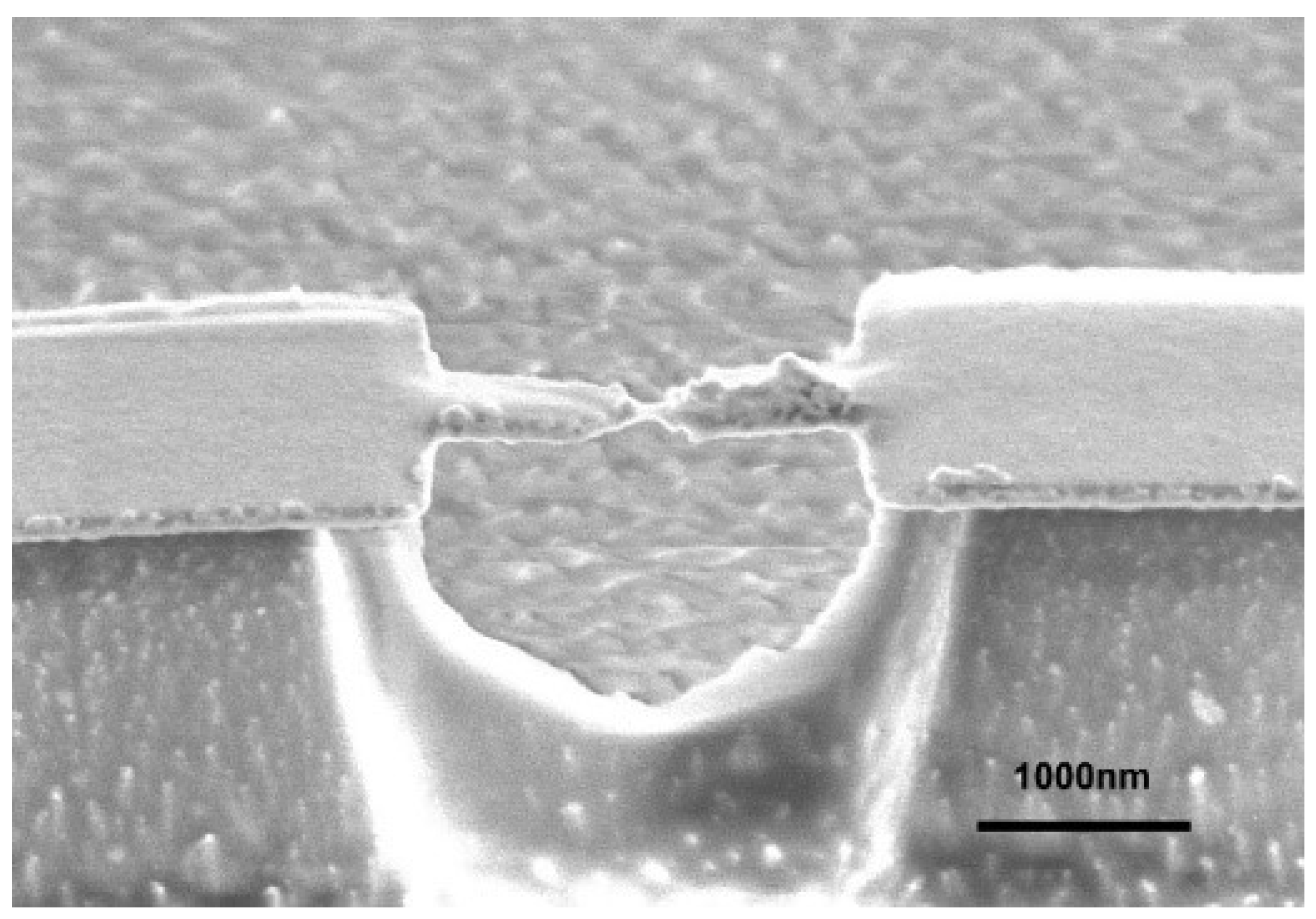
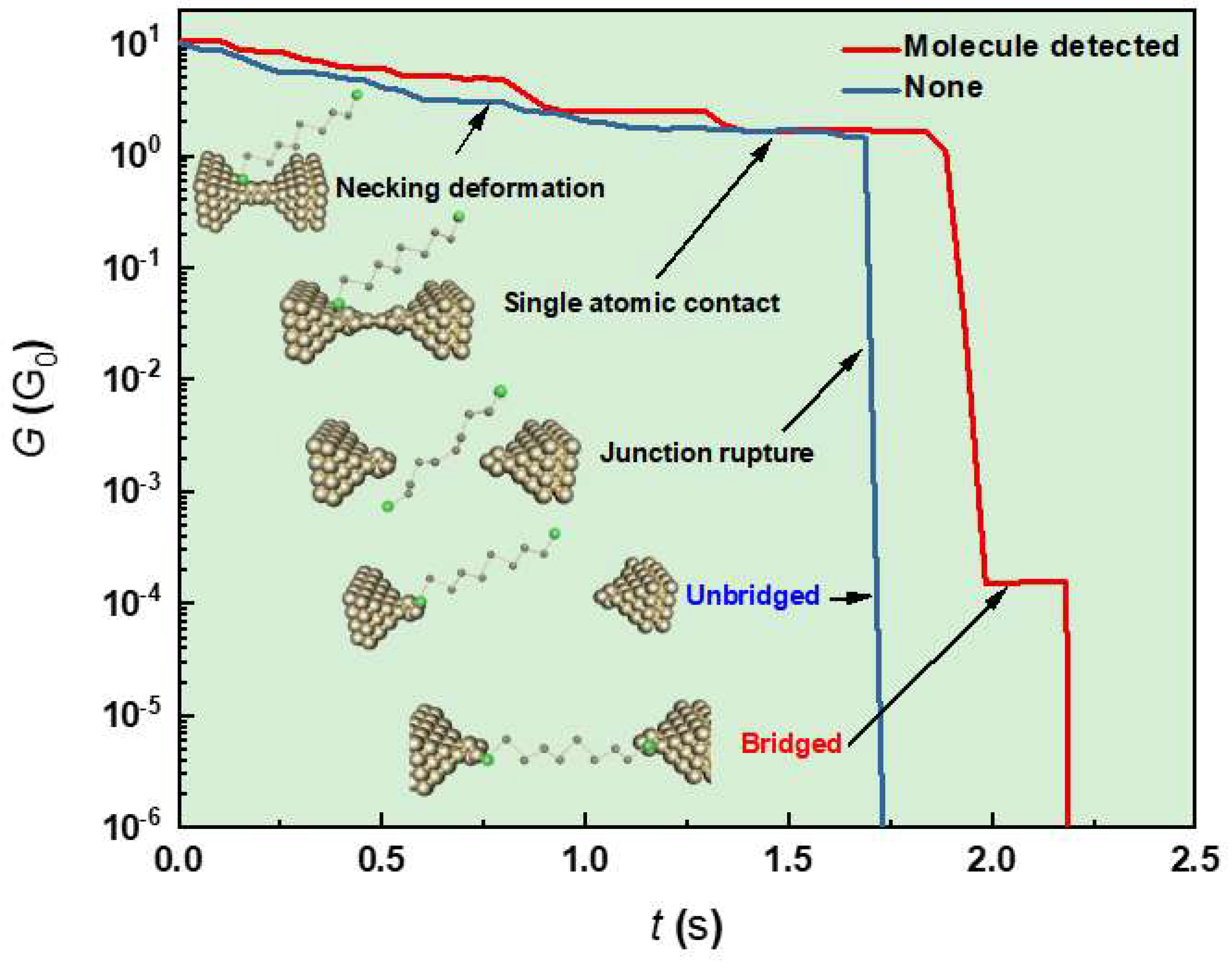
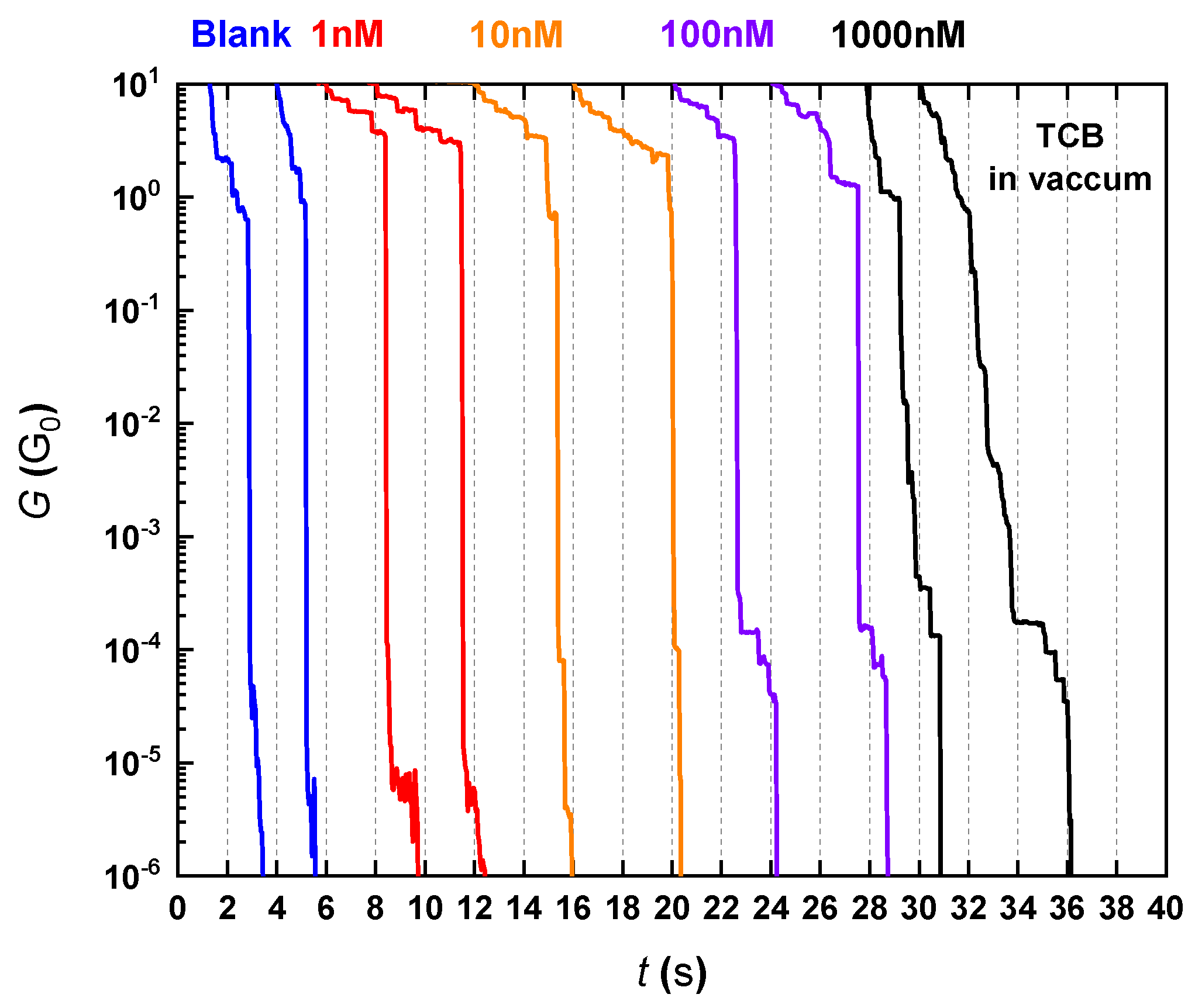
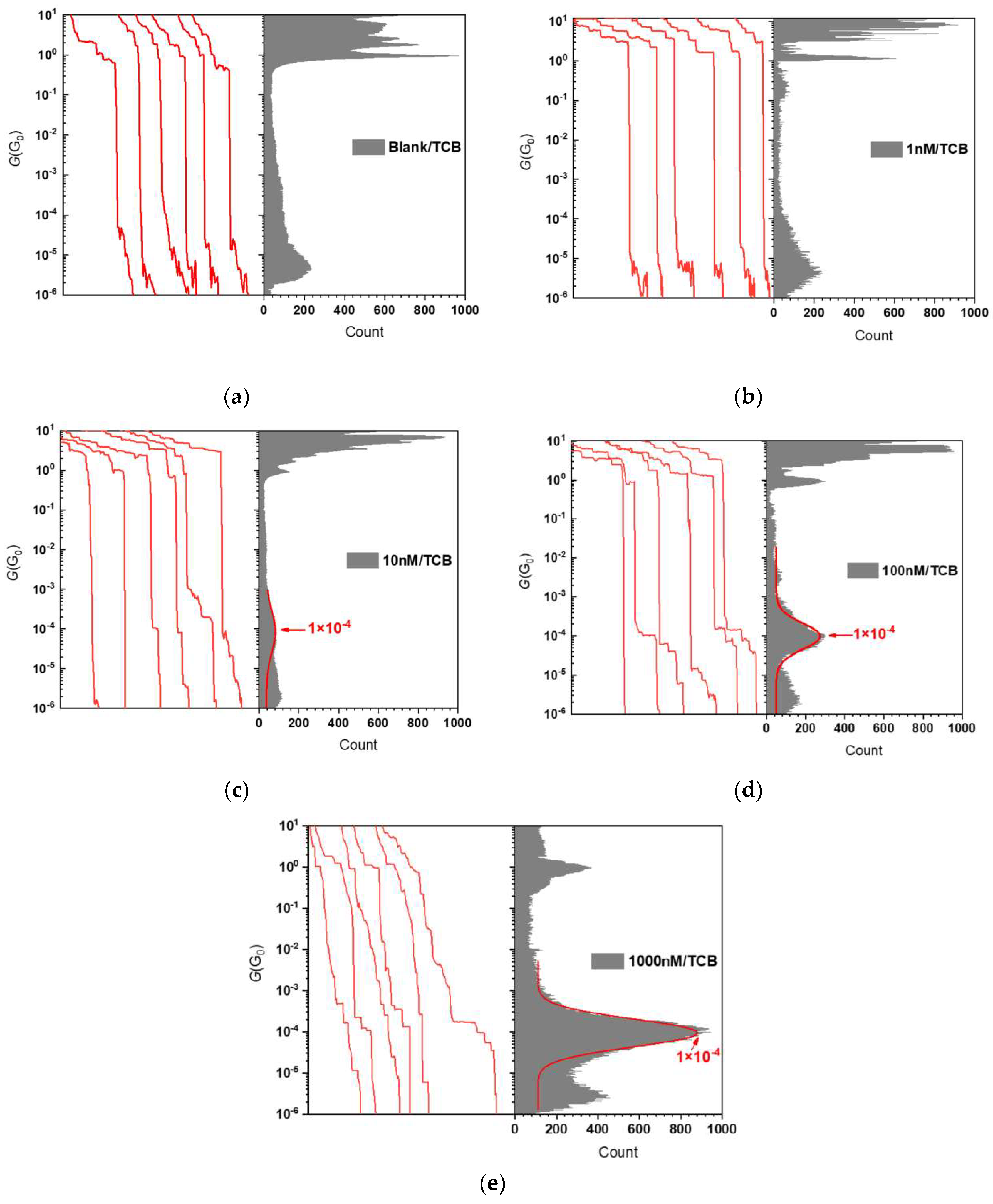


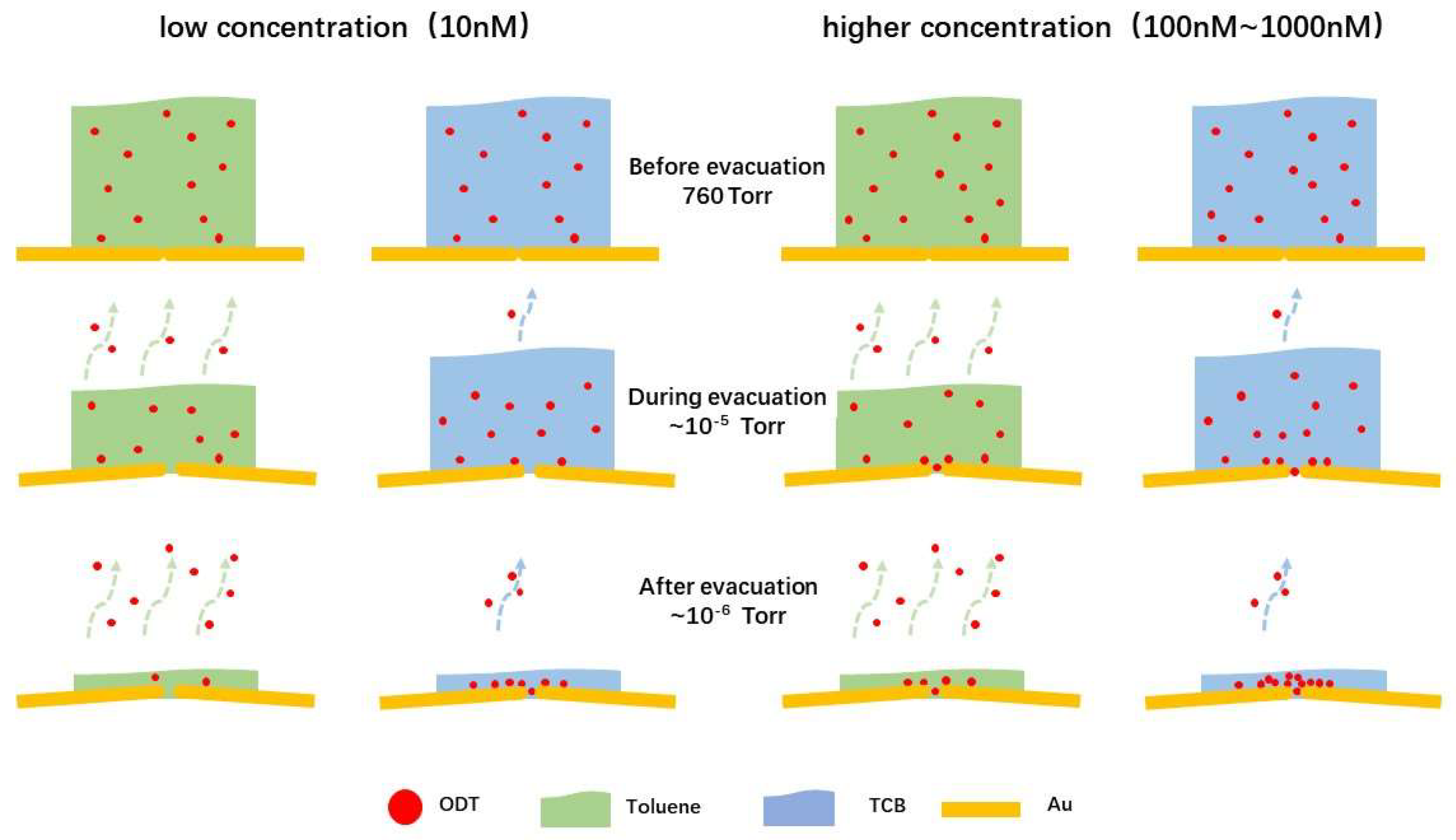

© 2018 by the authors. Licensee MDPI, Basel, Switzerland. This article is an open access article distributed under the terms and conditions of the Creative Commons Attribution (CC BY) license (http://creativecommons.org/licenses/by/4.0/).
Share and Cite
Liu, B.; Tsutsui, M.; Taniguchi, M. Measuring Single-Molecule Conductance at An Ultra-Low Molecular Concentration in Vacuum. Micromachines 2018, 9, 282. https://doi.org/10.3390/mi9060282
Liu B, Tsutsui M, Taniguchi M. Measuring Single-Molecule Conductance at An Ultra-Low Molecular Concentration in Vacuum. Micromachines. 2018; 9(6):282. https://doi.org/10.3390/mi9060282
Chicago/Turabian StyleLiu, Bo, Makusu Tsutsui, and Masateru Taniguchi. 2018. "Measuring Single-Molecule Conductance at An Ultra-Low Molecular Concentration in Vacuum" Micromachines 9, no. 6: 282. https://doi.org/10.3390/mi9060282
APA StyleLiu, B., Tsutsui, M., & Taniguchi, M. (2018). Measuring Single-Molecule Conductance at An Ultra-Low Molecular Concentration in Vacuum. Micromachines, 9(6), 282. https://doi.org/10.3390/mi9060282





